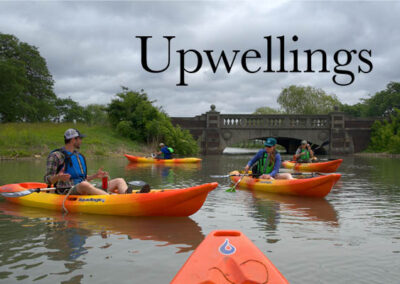 Earlier this summer, frogs, toads, and snakes invaded the Ann Arbor Senior Center.
Earlier this summer, frogs, toads, and snakes invaded the Ann Arbor Senior Center.
Fortunately, they had permission to be there — and they were being expertly handled by staff from Huron-Clinton Metroparks.
The animal visitors were part of the “School of Green” event, a community gathering hosted by Michigan Sea Grant summer intern Kyle Martin. A rising senior at Eastern Michigan University (EMU), Kyle is majoring in environmental science with a minor in zoology. He’s passionate about community-based environmental stewardship and serves as a volunteer aquatic field intern at the Huron River Watershed Council and as secretary of the newly formed Sierra Club chapter at EMU.
These interests made Kyle a great fit for his summer internship project: working with Citizen Science Educator Mike Reed at the Detroit Zoological Society. For the past several months, Kyle has been working with Mike and fellow intern Sarah Krzemien from Central Michigan University to organize community stewardship and outreach events in Southeast Michigan.
Kyle partnered with Huron-Clinton Metroparks to design and host “School of Green,” which brought together dozens of participants for presentations about environmental stewardship and conservation. This summer’s event, held July 26, focused on Michigan’s native reptiles and amphibians, collectively called “herpetofauna.”
 Kyle told participants that the goals of “School of Green: Herpetofauna” were to break down stigmas against these often-disliked creatures, showcase the diverse field of environmental science, bring a meaningful program to the community, and encourage environmentally friendly behaviors. He shared some ways to protect Michigan’s herpetofauna, such as staying on marked trails in parks, properly disposing of fishing line and hooks, and driving slowly through wetland areas during the spring breeding season.
Kyle told participants that the goals of “School of Green: Herpetofauna” were to break down stigmas against these often-disliked creatures, showcase the diverse field of environmental science, bring a meaningful program to the community, and encourage environmentally friendly behaviors. He shared some ways to protect Michigan’s herpetofauna, such as staying on marked trails in parks, properly disposing of fishing line and hooks, and driving slowly through wetland areas during the spring breeding season.
Staff from the Ann Arbor Natural Area Preservation program (NAP) talked about annual volunteer efforts to survey frogs, salamanders, and turtles in the city’s many parks. These volunteer opportunities are open to everyone in and around Ann Arbor, with no prior experience necessary.
Lisa from the Huron-Clinton Metroparks Mobile Learning Center then introduced her collection of herpetological guests. Even hesitant attendees were won over by animals like Greg the toad and Millie the milk snake.
 Finally, Michigan Sea Grant intern Sarah Krzemien discussed her summer project about the value of having educational park signs in multiple languages. Nearly half of Michigan’s Hispanic and Latino population and 80% of the state’s Arab-American population live in southeast Michigan. Having park signs and programming in multiple languages can help multilingual speakers feel more connected to their community and give opportunities to practice language skills.
Finally, Michigan Sea Grant intern Sarah Krzemien discussed her summer project about the value of having educational park signs in multiple languages. Nearly half of Michigan’s Hispanic and Latino population and 80% of the state’s Arab-American population live in southeast Michigan. Having park signs and programming in multiple languages can help multilingual speakers feel more connected to their community and give opportunities to practice language skills.
After the presentations, participants headed into the sunshine for a litter clean-up in Burns Park. The Ann Arbor Parks and Recreation Department’s GIVE 365 volunteer program provided trash grabbers and collection bags.
Kyle Martin later spoke about the event during Michigan Sea Grant’s August 8 internship symposium. “I’ve already started planning for next year,” he said. “The event is going to be adopted by the Sierra Club at Eastern Michigan University, and many of the same organizations I partnered with … have already started planning for next year’s theme.”
Kyle is eager to see future School of Green programs rotate through different groups of animals, such as birds, insects, or fish. “I’m really looking forward to having this event go on for years to come.”
To hear more from Kyle, Sarah, and other 2022 Michigan Sea Grant interns, watch the recorded internship symposium.
Michigan Sea Grant’s summer internship program funds undergraduate students working on Great Lakes stewardship or research projects. Follow us on social media or join our Upwellings newsletter list for more information about the 2023 application cycle.


